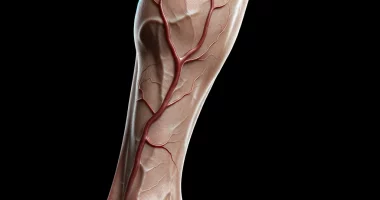Cutaneous T-cell lymphoma (CTCL)
Definition
Cutaneous lymphomas are malignant neoplasms of lymphatic tissue belonging to the group of non-Hodgkin’s lymphomas.
T-cell lymphomas account for about 80% of all skin lymphomas and most commonly affect 55-60-year-olds. Men are twice as likely to be affected as women.
Skin lymphoma is a tumor lesion resulting from the malignant multiplication of lymphocytes in the skin. T- and B-cell lymphomas are distinguished depending on the type of multiplying lymphocytes. The disease is manifested by forming nodules, plaques, or erythrodermic areas on the skin, accompanied by enlarged lymph nodes. Diagnosis is made by histologic examination of biopsy material from the affected area. Chemotherapy, radiation therapy, PUVA therapy, and extracorporeal photophoresis are used to treat skin lymphoma.
General information
Studies have shown that T-cell lymphomas of the skin occur in 65-70% of cases, while B-cell lymphomas account for 20-25%. Another 10% are so-called unclassifiable skin lymphomas.
Causes of skin lymphoma
The development of skin lymphoma is associated with a mutation of T- or B-lymphocytes that leads to their uncontrolled multiplication and migration into the skin. The exact causes that trigger this mechanism are not known. It is assumed that the emergence of a malignant clone of lymphocytes can be provoked by constant antigenic stimulation against the background of impaired immune defense of the body.
The provoking role is attributed to viral infections caused by retroviruses, cytomegalovirus, herpes simplex virus type 8, and Epstein-Barr virus. The action of various chemicals and carcinogens used in agriculture, the chemical industry, construction, and other areas can also cause skin lymphoma.
Skin lymphoma is primary when the disease begins in the dermis and secondary when lymphocytes migrate from the lymphoid organ in which they multiply. Such organs include bone marrow, thymus gland, lymph nodes, spleen, and lymphoid clusters along the respiratory and gastrointestinal tract.
Symptoms of skin lymphoma
Skin lymphomas are characterized by polymorphism of the rash (spots, plaques, nodules), varying degrees of severity of pruritus, and enlargement of peripheral lymph nodes. According to the degree of malignancy, distinguish lymphoma I, II, and III degrees. According to clinical manifestations, there are nodular, plaque, and erythrodermic forms. The nodular form of T-cell lymphoma of the first degree skin is characterized by small flat nodules the size of a millet grain. The nodules are lilac or yellowish, arranged in groups, and prone to spontaneous regression. In a more malignant course, the nodules enlarge, become cherry-colored, and lose their tendency to cluster. Patients die of metastases after 2-5 years.
The small nodular form of T-cell lymphoma of the skin, in which follicular nodules coalesce into plaques with psoriasis-like superficial desquamation, is rare. On this background, large nodules appear, which then undergo necrosis. The plaque form of T-cell lymphoma of the skin of the first degree is represented by indistinctly delimited plaques of yellowish color. The plaques may be larger than the palm. They gradually resolve with the formation of areas of atrophy and hyperpigmentation.
The grade II plaque form (Alibera mycosis fungoides) occurs in 26% of all skin lymphomas. It is characterized by a staged development. At first, flaky bright pink spots and other elements appear (erythematous stage). Then, in place of the spots, stagnant red plaques, often with a wet surface and peripheral growth, are formed (plaque stage). In the tumor stage, the plaques are replaced by flat nodules up to the size of an orange with necrosis in the center of the formation.
Erythrodermic form of T-cell lymphoma of the skin of the first degree (pre-Sézary syndrome) often develops on the background of long-standing, for 10-15 years, existing eczema or neurodermatitis. The skin is reddened and edematous, covered with large plates of white scales. There is a generalized increase in lymph nodes, nail dystrophy, hair loss, fever, and excruciating itching. After several years, the patient may die of cachexia, or the process progresses to erythrodermic form II degree (Sézary syndrome), characterized by marked infiltration, scaling, and dryness of the skin.
B-cell lymphomas of the skin are characterized by the absence of pruritus and other subjective sensations in grade I and II malignancy. They manifest in plaque and nodular forms. The plaque form is characterized by the same stages as T-cell lymphoma of the skin. The nodular form develops by forming one or more hemispherical nodules of dense-elastic consistency, the size of which reaches the size of a walnut.
Diagnosis of skin lymphoma
In many cases, skin lymphomas are accompanied by changes in the clinical blood count. T-cell lymphoma is characterized by leukopenia and monocytosis. In pre-Sézary syndrome, leukocytosis, neutrophilosis, and an increase in eosinophils are present. In Sézary syndrome, there may be an increase in leukocytes up to 30000-200000. B-cell lymphomas of the skin are characterized by the occurrence of normochromic and then hemolytic anemia.
Histologic and cytologic examination of material taken by biopsy of skin lymphoma elements and, if necessary, of lymph nodes is of decisive diagnostic value. A biopsy allows for the differentiation of T and B cell lymphoma of the skin and the determination of the degree of its malignancy. If internal organs are involved in the process, they are examined: abdominal ultrasound, lung radiography, CT scan of the lungs, etc.
Treatment of skin lymphoma
The primary method of treatment for patients with skin lymphoma is chemotherapy. It uses cytostatics (vincristine, vinblastine, cyclophosphan), corticosteroids (prednisolone, betamethasone), and interferons (gamma interferon). In the treatment of individual spots, plaques, and single tumors, radiation therapy, PUVA-therapy, and phototherapy are used. In some cases, extracorporeal photophoresis is effective. Different methods of treatment and drugs are often combined. For example, radiation is prescribed together with and after chemotherapy.
All these treatment options are available in more than 680 hospitals worldwide (https://doctor.global/results/diseases/cutaneous-t-cell-lymphoma-ctcl). For example, Chemotherapy for lymphoma can be done in 14 clinics across Israel (https://doctor.global/results/asia/israel/all-cities/all-specializations/procedures/chemotherapy-for-lymphoma).
Prognosis
If treatment is started promptly and the skin lymphoma is of grade I-II malignancy, achieving a significant remission and prolonging the patient’s life is often possible. Intercurrent diseases or complications of treatment lead to death in this case. If skin lymphoma is diagnosed in the tumor stage or has a pronounced malignancy, the prognosis is highly unfavorable; a lethal outcome may occur two years after the onset of the disease. -cell lymphomas – often relapse prognosis depends on the stage of the disease. For stage IA, the 6-year survival rate is 96%; for IB-IIA, it is 73%; for IIB-III, it is 44%; and for stage IV it is 27%. In most of the cases, the cause of death is due to diseases unrelated to the underlying diagnosis. However, 25% of patients die from lymphoma, leading to infections and immunosuppression.

